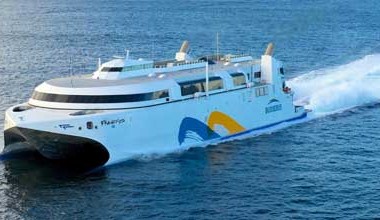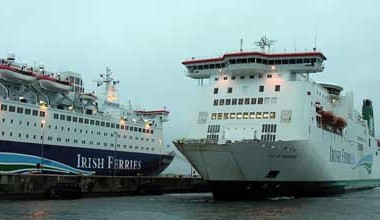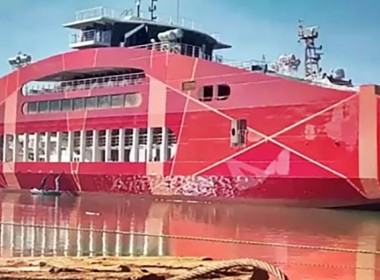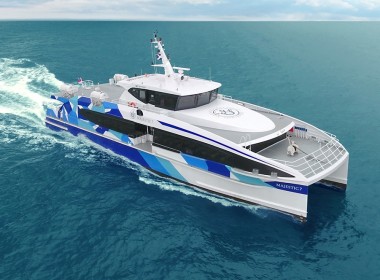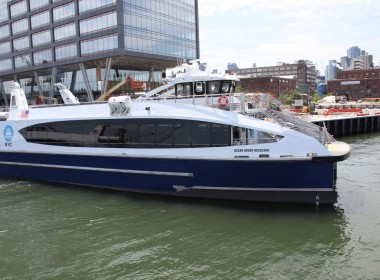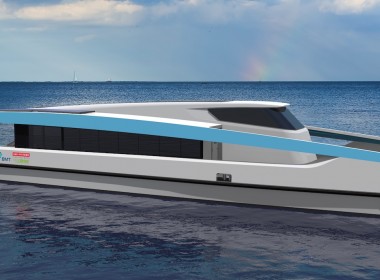COLUMN | And then there was one [Ferry Tales]

The sight of the giant fast ferry HSS Discovery lying broken on the beach at Aliaga in August was rather depressing. For any ship to go the breakers at just 17 years old is ludicrous, but to see the end of a craft which, along with her two sisters, promised so much to the ferry industry is somewhat surreal.
Built as the Stena Discovery at a cost of £65 million (US$100 million), the futuristic catamaran was the last of three HSS 1500 craft to be completed at Finnyards in Rauma. Delivered to Stena Line in April 1997, the HSS operated on the Harwich, England-Hook of Holland, Netherlands route until January 2007. Sky rocketing fuel costs saw the end of the HSS concept on the North Sea and the craft was bought by a Venezuelan company in May 2009, departing Belfast for La Guairá under the ownership of Albamar Shipping Company.
In November 2011 the HSS Discovery was moved to the Caribbean island of Curacao in an attempt to attract investors for a new ferry service from there to La Guairá. That all went the shape of the pear when she was subject to a criminal investigation shortly afterwards regarding the illegal trade of diesel. She never entered service in Venezuela and was sold to Turkish breakers for US$2.1 million earlier this year having never carried a fare-paying passenger since leaving the UK.
Following the recycling of sister Stena Voyager at Landskrona last year, there now only remains one HSS 1500, the Stena Explorer – first to enter service in 1996. Having been withdrawn from Irish Sea service in September last year, the Stena Explorer has been laid up at Holyhead and is expected to follow the HSS Discovery to the breakers any time now.
The fast ferry days
I received a very poignant photo from my friend Captain Trevor Bailey in September capturing the master/pilot exchange onboard his most recent command, the beautiful little five star cruise ship Hebridean Princess at Holyhead. The photo shows he and his old colleague and shipmate Captain Tudor Roberts on the bridge wing with the Stena Explorer in the background. Both had proud command of the HSS when she was introduced in those heady fast ferry days of 1996. Ironically, it was Captain Roberts who brought the HSS Discovery from the UK to Venezuela.
Trevor pointed out that the telegraphs of the Hebridean Princess are set to FWE and for HSS that is sadly appropriate.
Trevor said, “At the time that we took the HSS into service, we both considered that we had the best job in the world – I still do, even if the ship is different!”
This is a view shared by nearly anybody who was involved with the HSS back in 1996, myself included. I well recall that early spring morning when the Stena Explorer came into my homeport for the first time on berthing trials. This was the world’s largest fast ferry and the first designed to carry lorries, trailers and coaches as well as passengers and cars, setting new standards in capacity, speed and overall efficiency for the industry. Up to 1,500 passengers and 375 cars were transported comfortably at a cruising speed of 40 knots within a 126-metre long and 40-metre wide semi SWATH catamaran and our route between Holyhead and Dun Laoghaire was selected by Stena Line as the first to receive this giant.
Shoreside we all went through extensive training as our old and tired passenger terminals were swept away to be replaced with facilities modeled on an airport. Unique was the docking technique to speed loading and unloading, as well as a system for storing supplies, enabling her to be turned around, re-stored and refuelled in just 30 minutes. The shoreside linkspan was a completely new design, including a quick coupling with fuel, fresh water and waste water pipes.
The craft berthed stern first into the securing systems of the linkspan using finely-tuned differential GPS navigation system accurate to within 20cm, four CCTV cameras, a special docking radar mounted low in the stern and twin bow thrusters. Once contact was made with the linkspan fender quick couplings were connected on either side of the stern, pulling her into position so that the gangways, drive-on ramps and couplings fit – all completed without mooring ropes.
Several HSS design solutions were patented by Stena Rederi and the hull form was the result of a long series of tests carried out by the National Swedish Experimental Ship-building Tank Laboratories in Gothenburg and by DNV in Oslo, the classification society of the vessel. Excellent seagoing characteristics were achieved with heave and pitch largely eliminated, all in all giving a comfortable ride in 4.5-metre significant wave heights. We all wanted an operating parameter of up to seven metres, but the UK’s MCA had other ideas and probably rightly so! On one trial in heavy weather the Stena Explorer found seven metre significant waves off the southeast coast of Ireland and while she was fairly comfortable an MES slide was lost as was the aft docking radar from her transom!
A unique and highly innovative development for Stena Line the HSS took much of its technology from the world of aviation. The smaller of the two different types of gas turbines onboard are used in the Swedish Airforce’s fighter, attack and reconnaissance aircraft, the Saab Gripen, while the larger of the two types is used in the long-haul Boeing 747 aircraft. The turbines came with many benefits: they produced cleaner exhaust fumes than conventional diesel engines, required less space, weighed less and provided a high level of operational reliability. However, they are also incredibly thirsty engines and the spiraling costs of operating the Stena Voyager became too high. When the craft was first put into service fuel was approximately US$18 per barrel but this rose to a peak of around US$146 per barrel, and for a fuel hungry vessel this was simply untenable.
For the Stena Explorer it has been the long goodbye, with rumours of her withdrawal arising as long ago as 2008. Back then the company reduced the Stena Explorer’s cruising speed in an effort to significantly reduce water and wind resistance, thereby saving fuel.
But there is no reprieve this time. Even now with low fuel prices, the question everyone is asking “is this a blip?” And so Stena Line has moved on from its “Concorde of the Sea”, with big Ro-Pax ferries for a balanced market of tourism and freight.


